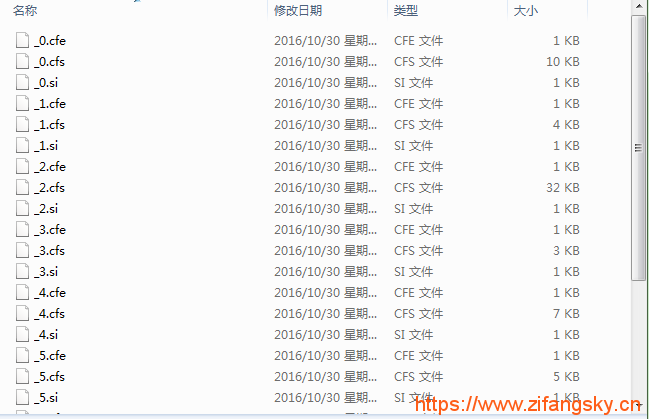全文检索:Apache Lucene框架入门实例
Posted
tags:
篇首语:本文由小常识网(cha138.com)小编为大家整理,主要介绍了全文检索:Apache Lucene框架入门实例相关的知识,希望对你有一定的参考价值。
一 简介
Lucene属于Apache开源项目的一部分,是一个开源的全文检索引擎工具包,但它不是一个完整的全文检索引擎,而是一个全文检索引擎的架构,提供了完整的查询引擎和索引引擎,部分文本分析引擎(英文与德文两种西方语言)
Lucene的目的是为软件开发人员提供一个简单易用的工具包,以方便在目标系统中实现全文检索的功能,或者是以此为基础建立起完整的全文检索引擎。在Java开发环境里Lucene是一个成熟的免费开源工具。就其本身而言,Lucene是当前以及最近几年最受欢迎的免费Java信息检索程序库。人们经常提到信息检索程序库,虽然与搜索引擎有关,但不应该将信息检索程序库与搜索引擎相混淆
注:以上介绍参考至百度百科
在使用Lucene建立索引时,可以选择将索引文件存储在内存中或者磁盘里。下面我将分别介绍基于这两种存储方式的全文索引的创建与检索
二 基于内存的索引创建与检索
首先需要做的是下载相关的jar包,下载地址是:http://lucene.apache.org/core/downloads.html
其次,在正式介绍下面的内容之前,至少需要导入以下三个jar包:
lucene-analyzers-common-6.2.1.jar
lucene-core-6.2.1.jar
lucene-queryparser-6.2.1.jar
基于内存的全文索引示例代码如下:
package cn.zifangsky.lucene;
import java.io.IOException;
import java.util.HashMap;
import java.util.Map;
import java.util.Map.Entry;
import org.apache.lucene.analysis.Analyzer;
import org.apache.lucene.analysis.standard.StandardAnalyzer;
import org.apache.lucene.document.Document;
import org.apache.lucene.document.Field;
import org.apache.lucene.document.StringField;
import org.apache.lucene.document.TextField;
import org.apache.lucene.index.DirectoryReader;
import org.apache.lucene.index.IndexReader;
import org.apache.lucene.index.IndexWriter;
import org.apache.lucene.index.IndexWriterConfig;
import org.apache.lucene.queryparser.classic.ParseException;
import org.apache.lucene.queryparser.classic.QueryParser;
import org.apache.lucene.search.IndexSearcher;
import org.apache.lucene.search.Query;
import org.apache.lucene.search.ScoreDoc;
import org.apache.lucene.store.Directory;
import org.apache.lucene.store.RAMDirectory;
public class Demo1 {
/**
* 创建索引
*
* @param sourceMap
* 待索引的内容
* @return
*/
public static Directory createIndex(Map<String, String> sourceMap) {
//1 创建一个默认的词法分析器
Analyzer analyzer = new StandardAnalyzer();
//2 设置索引文件存储位置,可以存储到磁盘和内存中,这里设置为存储到内存
Directory directory = new RAMDirectory(); // 存储到内存
//3 索引的写入
IndexWriterConfig config = new IndexWriterConfig(analyzer);
try {
IndexWriter indexWriter = new IndexWriter(directory, config);
//将内容添加到索引中,每本书表示一个“文档”,并将每个文档进行存储
if (!sourceMap.isEmpty()) {
for (Entry<String, String> source : sourceMap.entrySet()) {
Document document = new Document();
//标题需要分词,使用TextField
document.add(new TextField("title", source.getKey(), Field.Store.YES));
//作者不需要分词,使用StringField
document.add(new StringField("author", source.getValue(), Field.Store.YES));
indexWriter.addDocument(document);
}
}
indexWriter.close();
} catch (IOException e) {
e.printStackTrace();
}
return directory;
}
/**
* 搜索
*
* @param directory
* @param searchWord
* 搜索关键词
*/
public static void readIndex(Directory directory, String searchWord) {
int preHits = 10; //获取前面多少个结果
try {
//1 打开一个文档
IndexReader indexReader = DirectoryReader.open(directory);
IndexSearcher indexSearcher = new IndexSearcher(indexReader);
Analyzer analyzer = new StandardAnalyzer();
//2 设置使用关键字检索,这里是检索标题
QueryParser parser = new QueryParser("title", analyzer);
Query query = parser.parse(searchWord);
//3 获取检索到的结果
System.out.println("总共有 " + indexSearcher.count(query) + " 个结果");
ScoreDoc[] hits = indexSearcher.search(query, preHits).scoreDocs;
System.out.println("当前有 " + hits.length + " 个结果,内容分别如下:");
//遍历检索到的“文档”
for (int i = 0; i < hits.length; i++) {
int docId = hits[i].doc;
Document hitDoc = indexSearcher.doc(docId);
System.out.println("《 " + hitDoc.get("title") + "》 作者: " + hitDoc.get("author"));
}
indexReader.close();
} catch (IOException | ParseException e) {
e.printStackTrace();
}
}
public static void main(String[] args) {
Map<String, String> books = new HashMap<>();
books.put("Java编程思想", "Bruce Eckel");
books.put("Java8实战", "Raoul-Gabriel Urma");
books.put("Spring入门经典", "Mert Caliskan");
books.put("Spring实战", "Craig Walls");
books.put("Spring Boot实战", "汪云飞");
books.put("Redis实战", "Josiah L. Carlson");
Directory directory = Demo1.createIndex(books);
Demo1.readIndex(directory, "Spring");
// Demo1.readIndex(directory, "实战");
}
}上面代码并不复杂,而且还有详细的注释,因此一些细节流程我就不多做介绍了。只是需要强调的一点是:
在创建索引时使用了这样的代码:
document.add(new TextField("title", source.getKey(), Field.Store.YES));其中,上面的Field.Store.YES表示在创建索引的同时将内容的原文(也就是:source.getKey())也存储到内存中。如果我们选择了Field.Store.NO,在创建索引和检索的时候都是没问题的,但是在最后是没法提取检索关键字所在的原文内容的
最后的输出结果如下:
总共有 3 个结果 当前有 3 个结果,内容分别如下: 《 Spring Boot实战》 作者: 汪云飞 《 Spring实战》 作者: Craig Walls 《 Spring入门经典》 作者: Mert Caliskan
三 基于磁盘的索引创建与检索
示例代码如下:
package cn.zifangsky.lucene;
import java.io.BufferedReader;
import java.io.File;
import java.io.FileReader;
import java.io.FilenameFilter;
import java.io.IOException;
import java.util.ArrayList;
import java.util.List;
import org.apache.lucene.analysis.Analyzer;
import org.apache.lucene.analysis.standard.StandardAnalyzer;
import org.apache.lucene.document.Document;
import org.apache.lucene.document.Field.Store;
import org.apache.lucene.document.StringField;
import org.apache.lucene.document.TextField;
import org.apache.lucene.index.DirectoryReader;
import org.apache.lucene.index.IndexWriter;
import org.apache.lucene.index.IndexWriterConfig;
import org.apache.lucene.queryparser.classic.QueryParser;
import org.apache.lucene.search.IndexSearcher;
import org.apache.lucene.search.Query;
import org.apache.lucene.search.ScoreDoc;
import org.apache.lucene.store.Directory;
import org.apache.lucene.store.FSDirectory;
public class Demo2 {
public static void main(String[] args) {
Demo2.createIndex("D:/test/source", "D:/test/index");
Demo2.searchIndex("D:/test/index", "apache");
}
/**
* 给一个目录下的所有文本文件创建索引
*
* @param sourceDir
* 待索引的文件目录
* @param indexDir
* 索引文件存储目录
* @return
*/
public static void createIndex(String sourceDir, String indexDir) {
List<File> fileList = getFileList(sourceDir);
if (fileList.size() > 0) {
// 遍历文件并分别创建索引
for (File file : fileList) {
StringBuffer stringBuffer = new StringBuffer();
stringBuffer.append(getFileContent(file));
// System.out.println("fileName: " + file.getName() + " filePath: " + file.getPath());
Analyzer analyzer = new StandardAnalyzer();
try {
File indexFile = new File(indexDir);
if (!indexFile.exists()) {
indexFile.mkdirs();
}
//存储到文件中
Directory directory = FSDirectory.open(new File(indexDir).toPath());
IndexWriterConfig config = new IndexWriterConfig(analyzer);
IndexWriter indexWriter = new IndexWriter(directory, config);
Document document = new Document();
document.add(new TextField("fileName", file.getName(), Store.YES));
document.add(new TextField("content", stringBuffer.toString(), Store.YES));
document.add(new StringField("path", file.getPath(), Store.YES));
indexWriter.addDocument(document);
indexWriter.commit();
indexWriter.close();
} catch (IOException e) {
e.printStackTrace();
}
}
}
}
/**
* 在索引目录下检索关键字
*
* @param indexDir
* 索引文件存储目录
* @param searchWord
* 搜索的关键字
*/
public static void searchIndex(String indexDir, String searchWord) {
Analyzer analyzer = new StandardAnalyzer();
try {
//从一个磁盘目录中检索
Directory directory = FSDirectory.open(new File(indexDir).toPath());
DirectoryReader directoryReader = DirectoryReader.open(directory);
IndexSearcher indexSearcher = new IndexSearcher(directoryReader);
// 检索正文
QueryParser queryParser = new QueryParser("content", analyzer);
Query query = queryParser.parse(searchWord);
// 检索前1000个结果
System.out.println("总共有 " + indexSearcher.count(query) + " 个结果");
ScoreDoc[] hits = indexSearcher.search(query, 1000).scoreDocs;
System.out.println("当前有 " + hits.length + " 个结果,分别如下:");
for (int i = 0; i < hits.length; i++) {
int docId = hits[i].doc;
Document hitDoc = indexSearcher.doc(docId);
System.out.println("文件名: " + hitDoc.get("fileName") + " 路径: " + hitDoc.get("path"));
// System.out.println(hitDoc.get("content"));
}
directoryReader.close();
directory.close();
} catch (Exception e) {
e.printStackTrace();
}
}
/***
* 获取一个目录下的所有文件
*
* @param sourceDir
* 文件目录
* @return 所有文件的集合
*/
private static List<File> getFileList(String sourceDir) {
File dir = new File(sourceDir);
if (dir.isDirectory()) {
// 返回指定格式的文本文件
File[] files = dir.listFiles(new FilenameFilter() {
public boolean accept(File dir, String name) {
return name.endsWith(".txt") || name.endsWith(".log") || name.endsWith(".xml");
}
});
List<File> fileList = new ArrayList<File>();
if (files.length > 0) {
for (File tmpFile : files) {
fileList.add(tmpFile);
}
}
return fileList;
}
return null;
}
/**
* 获取一个文本文件的所有内容
*
* @param file
* @return
*/
private static StringBuffer getFileContent(File file) {
try {
// BufferedReader reader = new BufferedReader(new InputStreamReader(new FileInputStream(file), "UTF-8"));
BufferedReader reader = new BufferedReader(new FileReader(file));
String line = null;
StringBuffer stringBuffer = new StringBuffer();
while ((line = reader.readLine()) != null) {
stringBuffer.append(line + "\n");
}
reader.close();
return stringBuffer;
} catch (Exception e) {
e.printStackTrace();
}
return null;
}
}从上面的代码可以看出,索引存储到内存或者磁盘上,其基本步骤是差不多的,只是使用的类稍有区别。同时多了一些基本的IO操作代码,包括文件的读写等操作
运行上面的索引创建方法之后,打开磁盘上的“D:/test/index”,可以发现多了很多这样的文件:
最后,检索关键字“apache”,检索到的结果如下:
总共有 3 个结果 当前有 3 个结果,分别如下: 文件名: Lucene简介.txt 路径: D:\test\source\Lucene简介.txt 文件名: H5_ws.log 路径: D:\test\source\H5_ws.log 文件名: Shiro简介.txt 路径: D:\test\source\Shiro简介.txt
可以发现,有三个文件包含“apache”这个关键字
至此,Lucene的入门介绍到此结束
参考文章:
PS:上面图片中的水印是我个人博客的域名,因此还请管理员手下留情不要给我标为“转载文章”,谢谢!!!
本文出自 “zifangsky的个人博客” 博客,请务必保留此出处http://983836259.blog.51cto.com/7311475/1880295
以上是关于全文检索:Apache Lucene框架入门实例的主要内容,如果未能解决你的问题,请参考以下文章
